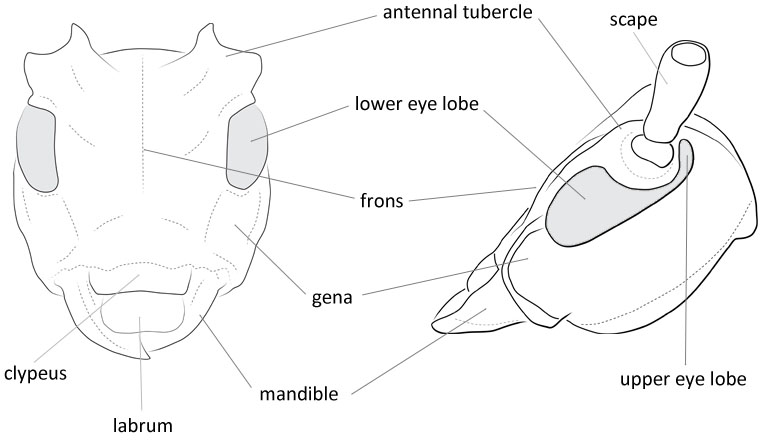Body length: 5.5–18 mm.
Eyes: eye interommatidial setaeseta:
a sclerotized hair-like projection of the cuticle
absent, eye deeply emarginateemarginate:
notched at the margin > half width or divided-max one row of facets between, eye ommatidial density fine.
> half width or divided-max one row of facets between, eye ommatidial density fine.
Antennaeantenna:
in larval and adult insects, paired segmented appendages, borne one on each side of the head, functioning as sense organs and bearing a large number of sensilla
: antennal length reaches between basebase:
the part of any appendage or structure that is nearest the body
and end of elytraelytron:
the leathery forewing of beetles, serving as a covering for the hind wings, commonly meeting opposite elytron in a straight line down the middle of the dorsum in repose
, antennal flagellar segments elongateelongate:
much longer than wide
, scapescape:
the first proximal segment of the antenna smooth/punctate at apexapex:
smooth/punctate at apexapex:
end of any structure distad to the base
, antennal scapescape:
the first proximal segment of the antenna ≥ segment 3, rarely segment 3 > scapescape:
≥ segment 3, rarely segment 3 > scapescape:
the first proximal segment of the antenna .
.
Pronotumpronotum:
the upper and dorsal part of the prothorax
: pronotumpronotum:
the upper and dorsal part of the prothorax
shape transversetransverse:
broader than long
, pronotumpronotum:
the upper and dorsal part of the prothorax
lateral armature absent.
Prosternum: prosternal process not dilated at apexapex:
end of any structure distad to the base
, procoxal cavities open posteriorly.
Elytraelytron:
the leathery forewing of beetles, serving as a covering for the hind wings, commonly meeting opposite elytron in a straight line down the middle of the dorsum in repose
: elytral length reaching or close to end of abdomen, elytral apicesapex:
end of any structure distad to the base
rounded or truncatetruncate:
cut off squarely at the tip
, elytral color black, brown, metallic, reddish or orange, elytral color pattern present or absent.
Legs: visible tarsomerestarsomere:
subdivision or article of the tarsus, usually numbering from two to five : 4, femora clavateclavate:
: 4, femora clavateclavate:
thickening gradually toward the tip
or slender, protibial spursprotibial spur:
sclerotized spine(s) located at the distal tibia; can be single, double, or absent : 2, tarsal clawstarsal claw:
: 2, tarsal clawstarsal claw:
usually paired claws of the pretarsus, at the distal end of the leg simple.
simple.
Body broad, flattened. Antennaeantenna:
in larval and adult insects, paired segmented appendages, borne one on each side of the head, functioning as sense organs and bearing a large number of sensilla
11-segmented and shorter than body in both sexes; second segment nearly twice as long as broad; maxillary palpi but little longer than labial palpi; eyes not embracing antennal insertion. Pronotumpronotum:
the upper and dorsal part of the prothorax
broader than long, sides rounded; anterior coxal cavities confluent, intercoxal process triangular; mesonotum with coarse, scattered punctures on stridulatory area; mesosternummesosternum:
sternum of the mesothorax
obtusely triangular. Femora clavateclavate:
thickening gradually toward the tip
; first segment of posterior tarsitarsus:
the leg segment distal to the apex of the tibia, bearing the pretarsus; consists of one to five tarsomeres (including pretarsus)
more than twice as long as broad, longer than following two segments together (Linsley 1964Linsley 1964:
Linsley EG. 1964. The Cerambycidae of North America. Part V. Taxonomy and Classification of the Subfamily Cerambycinae, Tribes Callichromini Through Ancylocerini. University of California Publications in Entomology, Vol. 22. 197 pp.).
Pyrrhidium, Callidiellum, Elatotrypes, Meriellum, Phymatodes
Callidiellum has more strongly clavateclavate:
thickening gradually toward the tip
femora and the pronotumpronotum:
the upper and dorsal part of the prothorax
laterally arcuatearcuate:
arched or bow-like
and widest at middle. The orange color of Pyrrhidium will easily differentiate it from Callidium. Elatotrypes has three longitudinal calli that span the pronotumpronotum:
the upper and dorsal part of the prothorax
.
Holarctic
Pinaceae; Cupressaceae; also recorded from broadleaf trees
38 species in subgenus (Callidium), including 6 incerte sedis; 1 sp. (Callidostola); 3 spp. (Paleocallidium). All species with host records prefer conifers. The prosternal processprosternal process:
a posterior extension of the prosternum between the coxae wide and continuous through the coxae in subgenus Paleocallidium will differentiate it from Callidium and Callidostola.
wide and continuous through the coxae in subgenus Paleocallidium will differentiate it from Callidium and Callidostola.
Meridion Des Gozis, 1886 [for Callidium]
Rhopalopus (Calliopedia) Binder, 1915 [for Callidostola]
Subgenus Callidium Fabricius, 1775
Subgenus Callidostola Reitter, 1912
Subgenus Palaeocallidium Plavilstshikov, 1940